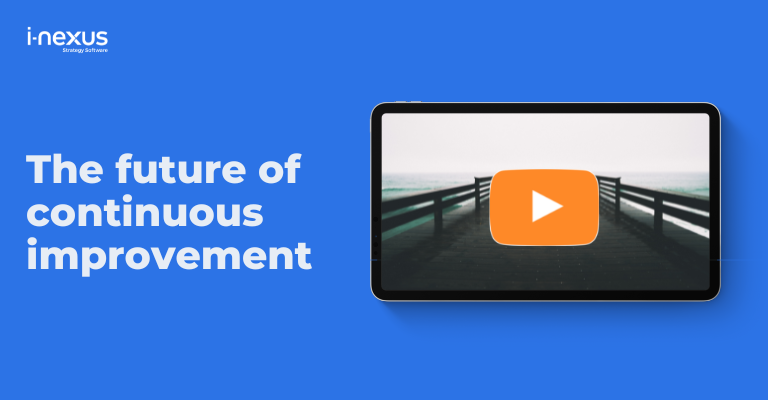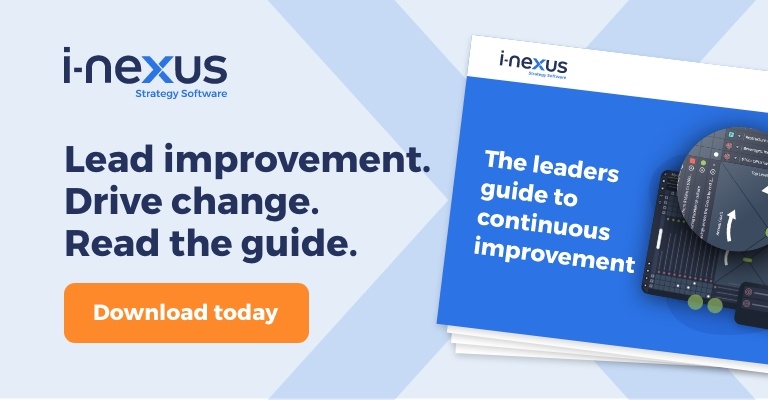To achieve business excellence, a key ingredient is improvement leadership, empowered teams, and change culture. Here is why it’s important to build this foundation for your improvement programs and projects to be successful, and what your team and culture should look like.
Written by: Nigel Richardson
As a leader of continuous improvement, you are overseeing a complex portfolio of change.
The journey towards business excellence is long, winding, and full of hurdles.
Just consider the change is going as far as:
- An overall transformation in thinking as to what a good operational foundation is
- Building confidence that individuals and teams can define and deliver improvements to their day job
- A change in mindset for the leaders of the organization about what constitutes performance and how this should be understood and discussed
- The complex suite of improvement projects at any one time being designed and delivered in pursuit of the improved customer, employee, or company value
- A mindset of commitment to a goal or target when, in many cases, the answer to how that will be delivered is unclear
This can be a large disruption to your business as it pursues a state of excellence.
So, a logical place to begin is to establish an understanding of the common frameworks of change management that are available to you.
Change management frameworks
Change management’s focus is on how a business can transition from a current set of practices and processes to a new version that can be applied and sustained across the entire organization.
For those that are looking to explore this topic in more detail, I would encourage you to research change management frameworks in general, but I will highlight the two below:
Accelerating Implementation Methodology (AIM)
https://www.imaworldwide.com/aim-change-management-training-programs
ADKAR Model from Prosci
Both methodologies have a particular approach to how change is planned, the environment is assessed and prepared, and then the focus is on execution, ensuring the change is reinforced.
I would encourage you to thoroughly read through these methodologies as they truly help with navigating and applying change.
And in the history of organizational change, I have yet to hear of a company that overdid change management.
People: The heart of change
One thing that runs across all change management models is the role of people in communicating and reinforcing the change.
That really needs to be kept in mind when thinking about the team that must exist for your improvement to thrive.
Personally, I am a fan of the AIM CAST of characters framework and would recommend you research further the definitions and theory that sit behind these headings by visiting this link.
The AIM CAST of characters framework
The key people that we are going to talk about as part of a team are:
1) Champion
They believe in the change or the future you are trying to achieve.
Any of the below roles can be a champion.
2) Agents of change
The people you are relying on to define and deliver the change.
3) Sponsor
The leaders and managers in the organization who need to reinforce the change.
4) Targets of change
The population of the organization that will receive the change.
As a continuous improvement leader, you really have influence over how you select and build your team of Agents and Sponsors.
Engaging with and understanding the Champion of improvement
If you have one or more Champions in your organization that means you have a powerful core of individuals who want your improvement in place.
In my experience, this is either driven by:
1) The current situation is frustrating to the point of being unbearable, and / or
2) Experience of a better way of doing things
They will be a powerful ally for you and often volunteer themselves as a sponsor or agent of the change depending on their level in the organization.
Navigating your network of Sponsors
Probably the single biggest source of literature, debate, and comment is the nature and quality of sponsorship that a change needs.
Here is a breakdown of my thoughts on sponsorship of improvement:
a) Your top-level sponsor
Often referred to as your champion.
Who is the person who has either brought you into the business or asked you to take a role focused on improvement?
This is a key person that you will rely on.
In a role in which you will be surfacing performance issues and challenging ingrained mindsets and behaviors, you will need to know that this person is fully supportive of you.
A couple of variables I have experienced that are worth keeping in mind when considering your top-level sponsor:
-
What are they accountable for?
-
Do they own a section of the P&L?
-
Do they have oversight of the day-to-day as well as a more transformational activity?
This is by no means a rule, but in my experience, the closer your sponsor is to the core operational and/or commercial performance, the more their relevance and power, and influence.
This makes your continuous improvement program more relevant and meaningful, in turn ensuring it is absolutely aligned to the targets that this leader owns. Accordingly, you move ever closer to the end goal of business excellence.
But, it is important to remember that there are numerous examples of corporately run continuous improvement programs which are successful as long as goals and targets are aligned.
iv. What is their mindset and experience?
In my experience, there is a powerful differentiator of senior sponsor and their view of what you and your improvement program is in place to provide which relates to their own background and experience.
v. Have they been here before?
vi. Have they done it themselves and therefore understand the challenges, investment, and time it can take?
vii. Have they seen it working well and therefore truly understand the value it can deliver?
viii. Do they know what challenges lie ahead and have experience as a sponsor in this space?
If the answer to the above is yes, it is highly likely that this person will have your back and provide you with some coaching and guidance.
vi. Are they championing you to deliver an outcome or a business case?
They may have a limited understanding of the key improvement methods or success criteria but sign up to a business case against the investment in business excellence, and ultimately empower you to deliver.
If your sponsor buys into this but has little or no prior experience, they can still provide you with massive value as a sponsor on how to navigate other stakeholders and provide useful input on scoping or prioritization.
It may be on your shoulders to educate this person as to what is required of a senior improvement sponsor.
You would also benefit from rapidly showing this sponsor an environment similar to your own that showcases the best practice you are looking to achieve.
b) Your remaining sponsors
There will be multiple leaders and managers across the organization that you will be looking to educate and influence to ensure that they talk, model, and reinforce the behaviors that nurture an improvement environment.
Rather than repeat the extensive research-based content available on the internet I thought I would share some pragmatic insights based on my own experience.
Ultimately you are looking for sponsors to do three things:
- Talk the talk
- Walk the walk
- Hold the line when things get tough
Clearly, the first place to start in assessing your sponsors is a repeat of the questions above relating to:
- Accountability and relevance
- Mindset and experience (remember there could be potential Champions)
Once that is clear, the additional variables below may be useful to consider:
i. Prior exposure to this type of program
The opportunity is to tap into leaders across the organization who could be candidates for your first wave or act as early-adopting functions.
The flip side is those managers who have had a poor experience of a business excellence effort in the past and who will, as a result, retain a cynical, suspicious and defensive attitude.
ii. How they feel about their targets
Are you helping them to deliver targets that they have agreed to and have taken accountability for?
Has your existence impacted that target?
The best-case scenario is that they own their numbers but are grateful for the help and support you can provide.
The worst-case scenario is they take no accountability for the targets and see them as your improvement targets to deliver rather than a performance metric that they own.
iii. How they feel about clarifying performance
It may be that they are already transparent about their performance and the help that they need internally and from others in the organization.
This is often especially true of those functions that are towards the end of a process or service journey.
The later stages often contain the impact of poor performance from the previous stage.
The alternative may be that they are very comfortable with communicating their performance in an absence of hard facts and would prefer things to stay as they are, obfuscated by poor KPI definition or measurement systems.
iv. How they value control
A healthy improvement environment has a healthy disrespect for authority.
Employees that become more aware and knowledgeable on their performance and areas for improvement can become spirited and challenging.
For a workforce to take accountability for working well, some level of empowerment must be given to allow people to shape how they do their job.
How much top-down control are the leaders of an area prepared to relinquish to really fuel the bottom-up improvement energy?
How will you manage this trade-off?
v. How they value fire fighting
Are your managers overwhelmed by endless phone calls with problems to solve?
Does this drain them, would they appreciate a little stability?
The flip side of this is firefighting is attractive, it can make a career (if the fire is big enough).
You may find a reluctance to implement improvements that prevent future fires.
The reality is you will need to find a way to reinforce sustained operational performance in a way that is stronger than the historic fire-fighting modes that were in place.
Remember – some of your sponsors will not start as champions.
They may need to be on the receiving end (i.e. be a target to start with) of one or more interventions to get them to embrace the sponsorship role and approach that needs to be reinforced.
Delivering for your Agents
These are the people you need to deliver and lead the changes and improvements across the organization.
They are generally split into two groups based on capability expected and capacity assigned.
A) Full-time change leader
These people do not have a day job.
They have often held accreditations such as Black Belt or Lean Level 2 and may also have accreditations in the above or other change management methods.
Often these people are a core team that reports directly to you the deployment leader.
You are relying on these people for three key things in my experience:
1) Building partnerships
Often aligned to key areas of the business, you are looking to provide experienced lead contacts who can embed themselves within the area of the business, build relationships with the leaders of the area and ideally participate in the leadership meetings
2) Leading improvement
Take the larger complex improvement projects and lead them to completion.
3) Developing the capability of others
Training and coaching of others is a key channel of improvement delivery and this will require experience in judgment on when to challenge vs when to support.
B) Part-time change leader
There will be an interesting level of continuous improvement to explore by certain key individuals in a business area who are protecting their day job but are also released often one day a week to focus purely on improvement delivery.
These people are often developed to a level of capability and accreditation such as Green Belt or Lean level 1 but still report into their existing business area.
You are relying on these people to:
- Lead improvement within the function with a pool of their peers show it can be done, and build that higher volume of improvement
- Support the adoption of the operational basics that may be being put in place in the area through coaching, support, and audits
When you are looking for part-time change leaders within your organization, never has the mantra of ‘hire for attitude, train for skill’ been more important.
Turning to your Targets
This is the group of people who need to change.
So, this will be the vast population of the workforce who will start to:
- See evidence of new ways of working (e.g. discussions on performance, visualization of information)
- Be on the receiving end of changes to how they do their job as and when improvements are made
The more you can understand the history and current reality of the different communities of people the more you, your change agents, and sponsors can plan to shift the norms.
Communication and awareness of the what and why are critical to this group.
Looking beyond improvement tools
Building a continuous improvement team is impossible without an improvement culture. After all, you are building a team to deploy a complex, interrelated organizational change.
It is prudent to look beyond improvement tools to other sources of best practice on how to prepare for this step.
AIM and ADKAR provide useful frames of reference and I would encourage you to research further in this space.
Moreover, consider assessing your execution engine with free assessments such as i-nexus' StratexAssess.com
My advice has come from many years of success and failure. I hope you find this a useful summary of some questions to ask when establishing the team and culture necessary for improvement to thrive.
Continue learning about continuous improvement
Click here to learn more about continuous improvement, or take a look at these content recommendations:
- Continuous improvement in 2020 and beyond: Watch how continuous improvement will evolve into the 2020s and how you can be successful.
- DMAIC v Six Sigma v Lean: Our guide to the steps and tools you'll need when driving process improvement through one of these three methodologies.
- The Leader's Guide to Continuous Improvement: Download this eBook to get a comprehensive overview of how DMAIC, Six Sigma, Lean, PDCA can support your business in finding competitive advantage.
About the author
Nigel Richardson is a continuous improvement expert. His background spans 20 years in business transformation and continuous improvement across retail, pharma, aviation and IT supply chain. He is passionate about supporting organizations to achieve their strategic, transformational and improvement goals, and outperform their peers year after year.
If you’d like to talk more about your strategic challenges, reach out to him on nigel.richardson@i-nexus.com or connect with Nigel on LinkedIn for the latest Strategy Execution insights.





